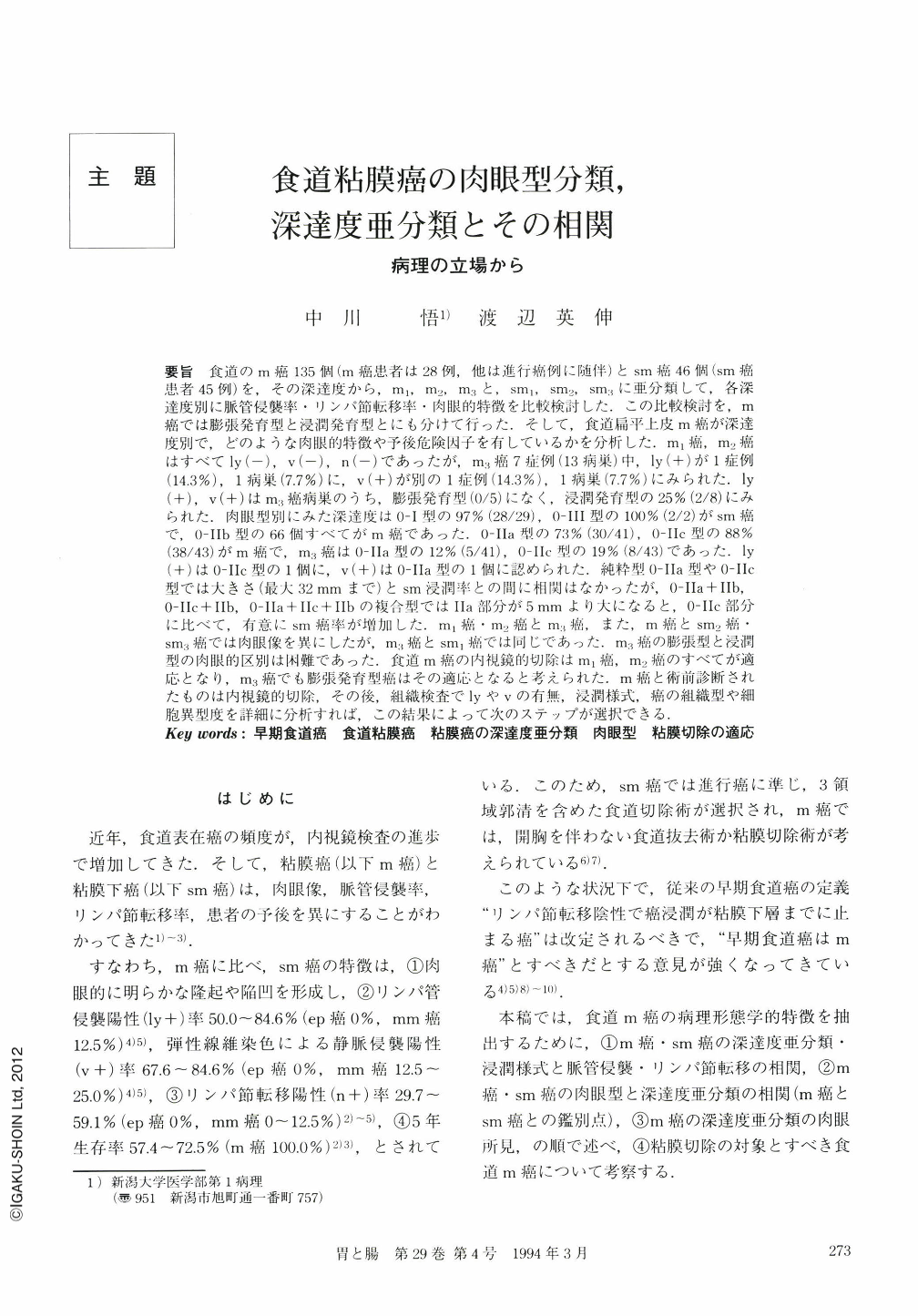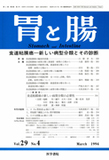Japanese
English
- 有料閲覧
- Abstract 文献概要
- 1ページ目 Look Inside
- サイト内被引用 Cited by
要旨 食道のm癌135個(m癌患者は28例,他は進行癌例に随伴)とsm癌46個(sm癌患者45例)を,その深達度から,m1,m2,m3と,sm1,sm2,sm3に亜分類して,各深達度別に脈管侵襲率・リンパ節転移率・肉眼的特徴を比較検討した.この比較検討を,m癌では膨張発育型と浸潤発育型とにも分けて行った.そして,食道扁平上皮m癌が深達度別で,どのような肉眼的特徴や予後危険因子を有しているかを分析した.m1癌,m2癌はすべてly(-),v(-),n(-)であったが,m3癌7症例(13病巣)中,ly(+)が1症例(14.3%),1病巣(7.7%)に,v(+)が別の1症例(14.3%),1病巣(7.7%)にみられた.ly(+),v(+)はm3癌病巣のうち,膨張発育型(0/5)になく,浸潤発育型の25%(2/8)にみられた.肉眼型別にみた深達度は0-Ⅰ型の97%(28/29),0-Ⅲ型の100%(2/2)がsm癌で,0-Ⅱb型の66個すべてがm癌であった.0-Ⅱa型の73%(30/41),0-Ⅱc型の88%(38/43)がm癌で,m3癌は0-Ⅱa型の12%(5/41),0-Ⅱc型の19%(8/43)であった.ly(+)は0-Ⅱc型の1個に,v(+)は0-Ⅱa型の1個に認められた.純粋型0-Ⅱa型や0-Ⅱc型では大きさ(最大32mmまで)とsm浸潤率との間に相関はなかったが,0-Ⅱa+Ⅱb,0-Ⅱc+Ⅱb,0-Ⅱa+Ⅱc+Ⅱbの複合型ではⅡa部分が5mmより大になると,0-Ⅱc部分に比べて,有意にsm癌率が増加した.m1癌・m2癌とm3癌,また,m癌とsm2癌・sm3癌では肉眼像を異にしたが,m3癌とsm1癌では同じであった.m3癌の膨張型と浸潤型の肉眼的区別は困難であった.食道m癌の内視鏡的切除はm1癌,m2癌のすべてが適応となり,m3癌でも膨張発育型癌はその適応となると考えられた.m癌と術前診断されたものは内視鏡的切除,その後,組織検査でlyやvの有無,浸潤様式,癌の組織型や細胞異型度を詳細に分析すれば,この結果によって次のステップが選択できる.
We studied 181 lesions of superficial squamous cell carcinoma of the esophagus (mucosal ca. 28 cases, 135 lesions and submucosal ca. 45 cases, 46 lesions) to evaluate histological risk factors (lymphatic and venous permeations, and lymph node metastasis), and macroscopic differentiation by subclassified depth (m1, m2, m3, and sm1, sm2, sm3) of their invasion, and by invasive pattern (expansive or infiltrative).
Carcinomas of m1 and m2 invasion revealed neither vessel permeation nor lymph node metastasis. One of 13 m3 carcinomas (7.7%) showed lymphatic permeation and another (7.7%) had venous permeation, both being infiltrative in growth pattern, but no lymph node metastasis were present in all of the 13 tumors.
Twenty eight of 29 0-Ⅰ type carcinomas (97%) and all of 2 0-Ⅲ type carcinomas were submucosal carcinomas and all of 66 0-Ⅱb type carcinomas or 0-Ⅱb areas of combined type carcinomas were mucosal ones. Thirty of 41 0-Ⅱa type (part) (73%) and 38 of 43 0-Ⅱc type (part) (88%) limited to the mucosa. The pure 0-Ⅱa or 0-Ⅱc type carcinomas had no correlation between size and sm invasion, but the 0-Ⅱa part which was more than 5 mm in size in combined type showed a significant incidence of sm invasion.
We assume that m1 or m2 carcinomas and m3 carcinomas with expansive growth are indication for endoscopic mucosal resection. After diagnostic mucosal resection, the lesion should be carefully examined whether it is m-carcinoma or sm1 carcinoma (surgical resection is necessary for sm1 carcinoma), and whether it is m3 carcinoma with ly(+), or v(+), or infiltrative (which requires surgical resection).

Copyright © 1994, Igaku-Shoin Ltd. All rights reserved.


